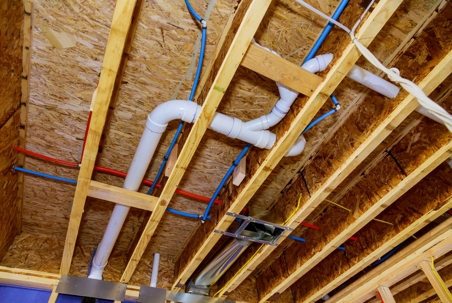Along with homeownership comes the responsibility of maintaining and replacing the various systems and fixtures around your property. The key to doing this successfully is knowing what these things need to work well and approximately how long they’ll last so that you can plan and budget appropriately. Your home’s plumbing system is one of its most essential components. Parts of this system will likely require replacements if you plan to stay in the same home for an extended time or if you’ve moved into an older home.
Below, we’ll explain how long you can expect your plumbing system’s different areas to last under typical conditions, according to the National Association of Home Builders and other experts.
Water heaters
The model and fuel type determine how long a water heater will last.
- Gas storage tank water heaters last around 10 years.
- Electric storage tank water heaters last around 11 years.
- Tankless water heaters can last well over 20 years.
Keep in mind: a storage tank water heater can last beyond the 10-year mark as long as you flush it periodically. Tankless water heaters also require flushing, and failing to flush out the mineral deposits that build up inside of the unit can negatively affect its efficiency and lifespan.
Pipes (copper, PEX, PVC, and cast iron)
Your pipes’ lifespan depends mainly on the material and the nature of the water passing through it. These are the general lifespans of different pipe types:
- Copper: Copper’s lifespan can vary greatly depending on the type of copper pipe used and the water’s acidity. To cut costs, some builders install M-type copper pipes, which are the thinnest variety, making them susceptible to corrosion and, therefore, leaks. These pipes can start leaking in as little as 20 years. L-type copper pipes are thicker and much more durable. These pipes generally last at least 50 years but can easily last up to 100.
- PEX: Due to its flexibility and durability, PEX piping should last at least 50 years.
- PVC / CPVC: Under typical conditions, these pipes should last up to 100 years. Keep in mind that PVC pipes are often used for drainage because extreme heat can damage them. CPVC pipes are heat-resistant and can be used for hot water lines.
- Cast iron: This drain line material lasts around 75 to 100 years.
Sewer lines
Everything that goes down a drain in your home must pass through your home’s sewer line to get to the city sewer system. Nowadays, residential sewer lines are commonly made of PVC or ABS. PVC pipes are generally the more flexible of the two, while ABS pipes are stronger. While these pipes can face some challenges underground, like roots and shifting earth, they should last up to 100 years.
If you live in an older neighborhood, you might have a sewer line made of clay, cast iron, or Orangeburg. Orangeburg is the least durable sewer line material and lasts about 30 to 50 years. Clay pipes last approximately 50 to 60 years and cast iron pipes last 75 to 100 years.
Faucets
Fortunately, if your faucet is having trouble, you don’t always have to replace the entire fixture. Sometimes, it’s a matter of replacing a worn-out washer or a broken cartridge. However, faucets do eventually need to be replaced. Bathroom sink, tub, and shower faucets should last at least 20 years. Kitchen faucets tend to go through more wear and tear, so they generally last around 15 years.
Showerheads
In theory, showerheads should last a lifetime. However, if you live in an area with hard water, the limescale that builds up inside the fixture can start taking a toll in just a few short years. To extend your showerhead’s lifespan, give it an overnight soak in white vinegar and scrub it with an old toothbrush.
Sinks
Again, your sink’s lifespan is highly dependent on the material.
- Porcelain: These sinks will last 25 to 30 years before needing to be “refinished,” which makes the sink just like new. In essence, these sinks can last as long as you want them to.
- Enamel steel: These are stainless steel sinks covered in an enamel coating. They last 5 to 10 years under consistent use.
- Stainless steel: A stainless steel sink will last 15 to 30 years.
- Soapstone: Soapstone sinks are extremely durable and can last well over 100 years.
Toilets
Unless a large crack forms in the tank or the bowl, a toilet does not require a replacement. The parts inside it might need adjusting or replacing from time to time. However, many people choose to replace their toilets not only for aesthetic reasons but to reduce water consumption. In fact, the EPA reports that the average family can save nearly 13,000 gallons of water annually by replacing their home’s old, inefficient toilets with WaterSense labeled models.
At EZ Flow Plumbing, LLC, our plumbing experts use only material and equipment made of the highest quality to ensure that your plumbing needs are met the right way: (480) 351-1820.

